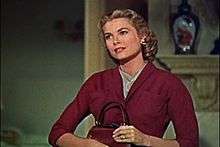Film career of Grace Kelly
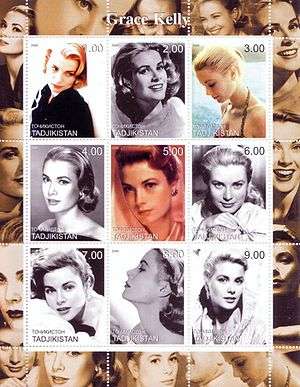
Grace Kelly has been cited as one of the most elegant and influential iconic film stars in American cinematic history. Her relatively short career of seven years occurred between 1950 and 1956, during which she appeared in just eleven films. In June 1999, the American Film Institute ranked her number thirteen on their list of top female stars of American cinema.
After a successful stint on stage, Kelly was approached by Hollywood producer Stanley Kramer, who offered her a co-starring role opposite Gary Cooper in the film High Noon (1952). In October 1953, with the release of Mogambo, she became a movie star, a status confirmed in 1954 with a Golden Globe Award and an Academy Award nomination as well as leading roles in five films, including The Country Girl, in which she gave a less than glamorized Academy Award-winning performance. She retired from acting at the age of twenty-six to begin her duties as princess consort of Monaco to Rainier III, Prince of Monaco.
Transition from theatre to film 1950-1951
Grace Kelly's uncle George Kelly, a Pulitzer Prize-winning playwright, advised and mentored Kelly during her Hollywood film career.[1] Her film career lasted from September 1951 to March 1956.[2]
As a theatre personality, she was mentioned in Theatre World magazine as: "[a] most promising personality of the Broadway stage of 1950". Some of her well-known works as a theater actress were: The Father, The Rockingham Tea Set, The Apple Tree, The Mirror of Delusion, Episode (for Somerset Maugham's tele-serial), among others.[3]
Impressed by her work in The Father, the director of the Twentieth Century-Fox film Fourteen Hours, Henry Hathaway, offered her a small role in the film. Kelly had a minor role opposite Paul Douglas, Richard Basehart, and Barbara Bel Geddes as a young woman contemplating divorce.[4] The film, which was released in March 1951, was re-released fifty years later when it became more popular. Her co-artist Paul Douglas commented of her acting in this film: "In two senses she did not have a bad side – you could film her from any angle and she was one of the most un-temperamental cooperative people in the business".[5]Following the release of this film, the "Grace Kelly Fan Club" was established. It became popular all over the United States with local chapters springing up and attracting many members. Kelly referred to her fan club as "terrifically amusing".[5]
High Noon, 1951
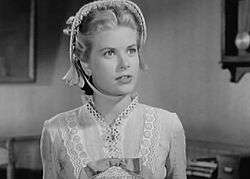
Kelly was performing in Colorado's Elitch Gardens when producer Stanley Kramer, offered her a role co-starring opposite Gary Cooper in Fred Zinnemann's High Noon, a western set in a historic old mining town in Columbia, CA. She accepted the role, and the film was shot in the late summer/early fall of 1951 over a 28-day shooting schedule in hot weather conditions. She was cast as a "young Quaker bride to Gary Cooper's stoic Marshall" and she wore a "suitably demure vaguely Victorian dress" alongside Gary Cooper, who was 30 years her senior.[4] The movie was released in the summer of 1952.[6] High Noon garnered four Academy Awards, and has since been ranked among the best films of all time.[7] However, High Noon was not the film that made Kelly a movie star, despite it now being one of her best-known films.[8] As biographer H. Haughland states: "Miss Kelly's acting did not excite the critics or live up to her own expectations".[4] Some critics scoffed at the conclusion of the film in which Cooper's character has to be saved by Kelly.[9][10] David Bishop argues that her pacifist character, killing a man who is about to shoot her husband, was cold and abstract.[10] Alfred Hitchcock described her performance as "rather mousy" and stated that it lacked animation. He said that it was only in her later films that she "really blossomed" and showed her true star quality.[7][11]
Acting lessons and continued success, 1952
After filming High Noon, Kelly returned to New York City and took private acting lessons, keen to be taken seriously as an actress.[4] As there were no film offers at the time, she also pursued her studies at the School of Theater, which helped to hone her acting skills.
She performed in a few dramas in the theater and in TV serials.[12] She appeared in several television plays (starring in over sixty television shows)[1] and screen tested for the film Taxi in the spring of 1952. Director John Ford noticed Kelly in a 1950 screen test, and his studio flew her out to Los Angeles to audition in September 1952. Ford said that Kelly showed "breeding, quality and class". She was given the role, along with a 7-year contract at the relatively low salary of $850 a week.[13] Kelly signed the deal under two conditions: first, that one out of every two years she had time off to work in the theatre, and second, that she be able to live in New York City at her residence in Manhattan House, at 200 E. 66th Street, now a landmark.[14]
Mogambo, 1953
_Cast.jpg)
Two months later, in November 1952, Kelly and the cast arrived in Nairobi to begin the production of the film Mogambo. Gene Tierney was initially cast in the role, but she had to drop out at the last minute due to personal issues.[15][16] Kelly later told Hollywood columnist Hedda Hopper, "Mogambo had three things that interested me: John Ford, Clark Gable, and a trip to Africa with expenses paid. If Mogambo had been made in Arizona, I wouldn't have done it".[17] Kelly plays Linda Nordley, a contemplative English wife with a romantic interest in Clark Gable. The costumes, designed by Helen Rose, were "safari style". Over the three-month shoot, no feminine looking outfits were used. The film was released in 1953 had a successful run at the box office.[13] Kelly was nominated for a Golden Globe Award for Best Supporting Actress, and received her first Academy Award nomination for Best Supporting Actress for her performance.[18]
Dial M for Murder, 1954
After the success of Mogambo, Kelly starred in the TV play The Way of an Eagle with Jean-Pierre Aumont before being cast in the film adaptation of Frederick Knott's Broadway hit Dial M for Murder opposite Ray Milland and Robert Cummings. In this film, Kelly plays the role of the wealthy wife of a retired professional tennis player .[13][19] Director Alfred Hitchcock, who had also seen the 1950 screen test, would become one of Kelly's last mentors. She was loaned by her studio MGM, (with whom she had signed a seven-year contract in order to do Mogambo), to work on several Hitchcock films, later appearing in Rear Window and To Catch a Thief.[20][13] Hitchcock became her friend and mentor, and called her the "epitome of the femme fatale". He took full advantage of Kelly's beauty on-camera while filming Dial M for Murder, later admitting that he had a strong fascination with elegant women such as Kelly. Hitchcock was enamored with her "sexual elegance" and brought it out in the film by changing her wardrobe from "bright to sombre" to match her character; however, for a scene in which an attempted murder takes place, Kelly herself chose to wear a velvet robe. Dial M for Murder opened in theaters in May 1954 to positive reviews and box-office success.
The Bridges of Toko-Ri, 1954
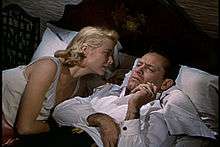
Kelly began filming scenes for her next film, The Bridges at Toko-Ri, in early 1954 with William Holden for Paramount Pictures. The story, based on the novel by James Mitchner, is about American Navy jet fighters stationed to fight in Asia. Kelly plays the role of William Holden's wife. Her dress designer was Edith Head, with whom she had established a friendly relationship. The upper-class outfits received a mixed reception from critics; one critic said that "Kelly's flavoring was just plain vanilla".[13]
Rear Window, 1954
Kelly turned down the opportunity to star alongside Marlon Brando in On the Waterfront, which won her replacement, Eva Marie Saint, an Academy Award. Instead she committed to the role of Lisa Fremont in Rear Window. She said: "All through the making of Dial M for Murder, he [Hitchcock] sat and talked to me about Rear Window all the time, even before we had discussed my being in it".[21] Much like the shooting of Dial M for Murder, Kelly and Hitchcock shared a close bond of humor and admiration.
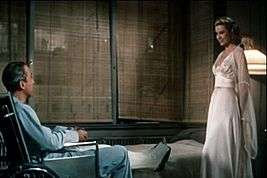
Kelly's new co-star, James Stewart, was highly enthusiastic about working with her.[22] The role of Lisa Fremont, a wealthy Manhattan socialite and model - a fashion model who "never wore her dress twice" [13] - was unlike any of the previous women she had played. For the first time she was playing an independent career woman. Just as he had done earlier, Hitchcock provided the camera with a slow-sequenced silhouette of Kelly, along with a close-up of the two stars kissing, finally lingering closely on her profile. Hitchcock brought her elegance to the fore by changing her dresses many times, including: "glamorous evening short dresses, a sheer negligee over a sleek night gown, a full skirted floral dress, and a casual pair of jeans".[13] On the film's opening in October 1954, Kelly was again praised. Variety's film critic remarked on the casting, commenting on the "earthy quality to the relationship between Stewart and Miss Kelly" as "both do a fine job of the picture's acting demands".[23]
The Country Girl, 1954
Kelly played the role of Bing Crosby's long-suffering wife, Georgie Elgin, in The Country Girl, after a pregnant Jennifer Jones bowed out. Already familiar with the play, Kelly was highly interested in the part. To do it, MGM would have to lend Kelly to Paramount. Kelly was adamant and threatened the studio saying that if they did not allow her to do the film she would pack her bags and leave for New York for good. MGM relented, and the part was hers. Kelly also negotiated a more lucrative contract in light of her recent success.[24] In the film, Kelly plays the wife of a washed-up, alcoholic singer, played by Crosby. Her character becomes torn emotionally between her two lovers played by Bing Crosby and William Holden. She was again dressed by Edith Head to suit her role in the film. She was initially dressed in fashionable dresses, but this wardrobe changed to ordinary-looking cardigans and "house dresses" toward the end of the film.[24]
As a result of her performance in The Country Girl, Kelly was nominated for the Academy Award for Best Actress. Her main competitor was Judy Garland for her performance in A Star Is Born. After receiving the Oscar nomination, Kelly won the New York Film Critics Circle Award for best actress for her performances in her three big movie roles of 1954: Rear Window, Dial M For Murder, and The Country Girl. At the Golden Globe Awards in 1955, Garland and Kelly both won awards for their respective performances. Garland won the Golden Globe Award for Best Actress in a Motion Picture – Comedy or Musical, and Kelly won the Golden Globe Award for Best Actress in a Motion Picture – Drama.
With every film, Kelly received greater acclaim. The New York Times praised her performance as excellent in The Country Girl, and Rear Window got her marquee credits on a par with and beyond those of James Stewart and Alfred Hitchcock.[25]
By the following March, the race between Kelly and Garland for the Oscar for the Best Actress in a Motion Picture was close. On the night of the Academy Awards telecast, March 30, 1955, Garland was unable to attend because she was in hospital having just given birth to her son, Joseph Luft. However, she was rumored to be the odds-on favorite and NBC Television cameras were set up in her hospital room so that if she was announced as the winner, Garland could make her acceptance speech live from her hospital bed. However, when William Holden announced Kelly as the winner, the technicians immediately dismantled the cameras without saying one word to Garland. Garland was reported not to have been very gracious about Kelly's win, saying in later years: "I didn't appreciate Grace Kelly taking off her makeup and walking away with my Oscar".
Green Fire, 1954
In April 1954, Kelly flew to Colombia for a 10-day shoot for her next project, Green Fire, with Stewart Granger. The film tells the story of emerald hunting in the forests of South America. Kelly plays Catherine Knowland, a coffee plantation owner. In Granger's autobiography he writes of his distaste for the film's script, while Kelly later confided to Hedda Hopper: "It wasn't pleasant. We worked at a pathetic village – miserable huts and dirty. Part of the crew got shipwrecked....It was awful".[17] Green Fire was a critical and box-office failure but made a small profit of $840,000.
To Catch a Thief, 1955
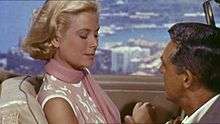
After the consecutive filming of Rear Window, Toko-Ri, Country Girl, and Green Fire, Kelly flew to the French Riviera to begin work on her third and last film for Alfred Hitchcock, To Catch a Thief. Lent by MGM to Paramount Films for the fifth time, Kelly plays the role of a temptress who wears "luxurious and alluring clothes", while Cary Grant plays the role of a former cat thief now looking to catch a "thief who is imitating him".[26] Kelly and Grant developed a mutual admiration. The two cherished their time together for the rest of their lives. Years later, when asked to name his all-time favorite actress, Grant replied without hesitation: "Well, with all due respect to dear Ingrid Bergman, I much preferred Grace. She had serenity".[27]
The Swan and High Society, 1956
In 1956, Kelly portrayed Princess Alexandra in the British film The Swan directed Charles Vidor, opposite Alec Guinness and Louis Jourdan.
Her final role was in Charles Walters's musical film High Society, a remake of the 1940 MGM classic The Philadelphia Story. In this film, she stars opposite Bing Crosby, Frank Sinatra, and Celeste Holm.[28]
The Swan and High Society were both shot in 1955. High Society premiered on 17 July 1956, three months after Kelly had married Prince Rainer on 18 April 1956.
Rearranged, 1979
In 1979, she and Rainier starred in a 33-minute independent film called Rearranged. It premiered in Monaco, then attracted the attention of ABC TV executives in 1982. They would air it on the condition that it be extended to an hour. Before this could happen, Kelly died. The film was never released, in short or long form.[29][30][31]
Legacy
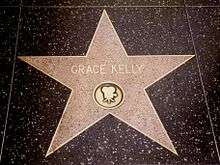
Kelly left a lasting legacy as a model, theater artist, television actress (her most prolific work, acting in around 100 TV plays), and an iconic Hollywood film star.[32] Kelly has been cited as one of the "classic Hitchcock blondes" and as one of the most elegant women in cinematic and world history.[33][34] One author describes her as the "elegant glamour girl of the screen",[35] and many of the photographic stills from the period of her film career are considered to be iconic.[36]
Grace Kelly appeared on the cover of the 31 January 1955 issue of the weekly magazine Time. The magazine hailed her as the top movie star who brought about "a startling change from the run of smoky film sirens and bumptious cuties". She was described as the "Girl in White Gloves" because she wore "prim and noticeable white gloves", and journalists often called her the "lady" or "Miss Kelly" for this reason as well. In 1954, she appeared on the Best Dressed list, and in 1955 the Custom Tailored Guild of America listed her as the "Best-tailored Woman".[37]
In appreciation of her work with Hitchcock in three of his films, Kelly later wrote a foreword to the book titled The Art of Alfred Hitchcock by Donald Spoto. Spoto had also written High Society: The Life of Grace Kelly.[38]
Filmography
| Year | Title | Role | Director | Co-stars |
| 1951 | Fourteen Hours | Louise Ann Fuller | Henry Hathaway | Paul Douglas, Richard Basehart, Barbara Bel Geddes |
| 1952 | High Noon | Amy Fowler Kane | Fred Zinnemann | Gary Cooper, Katy Jurado, Lloyd Bridges, Thomas Mitchell |
| 1953 | Mogambo | Linda Nordley | John Ford | Clark Gable, Ava Gardner |
| 1954 | Dial M for Murder | Margot Mary Wendice | Alfred Hitchcock | Ray Milland, Robert Cummings, John Williams |
| Rear Window | Lisa Carol Fremont | Alfred Hitchcock | James Stewart, Wendell Corey, Thelma Ritter, Raymond Burr | |
| The Country Girl | Georgie Elgin | George Seaton | Bing Crosby, William Holden | |
| Green Fire | Catherine Knowland | Andrew Marton | Stewart Granger | |
| The Bridges at Toko-Ri | Nancy Brubaker | Mark Robson | William Holden, Fredric March, Mickey Rooney, Earl Holliman | |
| 1955 | To Catch a Thief | Frances Stevens | Alfred Hitchcock | Cary Grant |
| 1956 | The Swan | Princess Alexandra | Charles Vidor | Alec Guinness, Louis Jourdan |
| High Society | Tracy Samantha Lord | Charles Walters | Bing Crosby, Frank Sinatra, Celeste Holm |
References
- Notes
- 1 2 "Grace Kelly biography". Biography.com. Retrieved 4 June 2013.
- ↑ Spoto 2010, p. 6.
- ↑ Spoto 2010, pp. 51–52.
- 1 2 3 4 Haugland 2006, p. 954.
- 1 2 Spoto 2010, p. 56.
- ↑ Spoto 2010, pp. 69–79.
- 1 2 Mcclure, Hal Hays (30 July 2012). Adventuring: My Life As a Pilot, Foreign Correspondent and Travel Adventure Filmmaker. AuthorHouse. p. 91. ISBN 978-1-4685-9812-4. Retrieved 3 June 2013.
- ↑ Browne, Ray Broadus; Browne, Pat (2001). The guide to United States popular culture. Popular Press. p. 458. ISBN 978-0-87972-821-2. Retrieved 3 June 2013.
- ↑ DiMare, Philip C. (17 June 2011). Movies in American History: An Encyclopedia: An Encyclopedia. ABC-CLIO. p. 411. ISBN 978-1-59884-297-5. Retrieved 3 June 2013.
- 1 2 Bishop, David (1 August 2006). The Wheel of Ideals. Lulu.com. p. 289. ISBN 978-1-84728-535-5. Retrieved 3 June 2013.
- ↑ Fawell, John (2004). Hitchcock's Rear Window: The Well-made Film. SIU Press. p. 142. ISBN 978-0-8093-8970-4. Retrieved 3 June 2013.
- ↑ Spoto 2010, pp. 79–85.
- 1 2 3 4 5 6 7 Haugland 2006, p. 956.
- ↑ Barbanel, Josh (28 October 2007). "The Kelly Connection". The New York Times. Retrieved 3 June 2013.
- ↑ "The Private Life and Times of Gene Tierney". Glamourgirlsofthesilverscreen.com. Retrieved 3 June 2013.
- ↑ Tierney; Herskowitz (1978). Self-Portrait. Wyden Books. pp. 150–151.
- 1 2 Hedda Hopper Collection. Maraget Herrick Library, Los Angeles.
- ↑ Haugland 2006.
- ↑ Hölting, Beatrice (14 June 2012). The Destruction and Re-creation of the 'Hitchcock Blonde' in "The Birds and Marnie". GRIN Verlag. p. 5. ISBN 978-3-656-21762-6. Retrieved 7 June 2013.
- ↑ Gottlieb, Sidney (1997). Hitchcock on Hitchcock: selected writings and interviews. University of California Press. p. 71. ISBN 978-0-520-21222-0. Retrieved 3 June 2013.
- ↑ Spoto, Donald (1983). The Dark Side of Genius: The Life of Alfred Hitchcock. Boston: Little, Brown. ISBN 0-306-80932-X.
- ↑ Eyles, Allen (September 1987). James Stewart. Stein & Day. ISBN 0-8128-8298-9.
- ↑ William Brogdon (July 14, 1954). "Rear Window". Variety. Retrieved 3 June 2013.
- 1 2 Haugland 2006, pp. 956–958.
- ↑ Elizabeth Gillen Surcouf (1 November 1992). Grace Kelly, American princess. Lerner. ISBN 978-0-8225-0548-8. Retrieved 4 June 2013.
- ↑ Haugland 2006, p. 957.
- ↑ Nelson, Nancy (December 2002). Evenings With Cary Grant. Citadel. ISBN 0-8065-2412-X.
- ↑ Curtis, Jenny (2002). Grace Kelly: a life in pictures. Barnes & Noble Books. ISBN 978-0-7607-3571-8. Retrieved 7 June 2013.
- ↑ Rearranged at IMDB
- ↑ Transcript of Larry King Live episode "Remembering Prince Rainer of Monaco", aired April 15, 2005 on CNN
- ↑ Grace: A Biography by Thilo Wydra, page 246.
- ↑ Spoto 2010, p. 5.
- ↑ D'Lugo, Marvin; Vernon, Kathleen M. (22 February 2013). A Companion to Pedro Almdovar. John Wiley & Sons. p. 58. ISBN 978-1-118-32538-4. Retrieved 7 June 2013.
- ↑ Curtis, Jenny (2002). Grace Kelly: a life pictures. Barnes & Noble Books. ISBN 978-0-7607-3571-8. Retrieved 3 June 2013.
- ↑ Peterson, Amy T (2008). The Greenwood Encyclopedia of Clothing Through American History 1900 to the Present: 1900–1949. ABC-CLIO. p. 15. ISBN 978-0-313-04334-5. Retrieved 3 June 2013.
- ↑ Tomshinsky, Ida (13 December 2011). Gloves: History and Present. Xlibris Corporation. p. 23. ISBN 978-1-4771-6052-7. Retrieved 3 June 2013.
- ↑ Haugland 2006, p. 960.
- ↑ Spoto 2010, p. 4.
- Bibliography
- Haugland, H. Kristina (2006). Grace Kelly: Icon of Style to Royal Bride (Philadelphia Museum of Art). Yale University Press. ISBN 978-0-300-11644-1.
- Spoto, Donald (1994). High Society: The Life of Grace Kelly. Crown Publishing Group. ISBN 978-0-307-39562-7.
- Spoto, Donald (2010). High Society: Grace Kelly and Hollywood. Random House. ISBN 978-0-09-951537-1.
- Wydra, Thilo (2014). Grace. A Biography. New York: Skyhorse Publishing. ISBN 978-1629145419.
